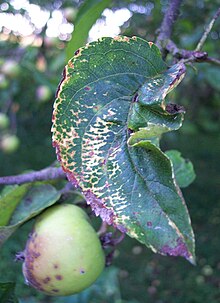Ilarvirus
| Ilarvirus | |
|---|---|

| |
| Apple mosaic virus | |
| Virus classification | |
| (unranked): | Virus |
| Realm: | Riboviria |
| Kingdom: | Orthornavirae |
| Phylum: | Kitrinoviricota |
| Class: | Alsuviricetes |
| Order: | Martellivirales |
| Family: | Bromoviridae |
| Genus: | Ilarvirus |
Ilarvirus is a genus of positive-strand RNA viruses in the family Bromoviridae.[2] Plants serve as natural hosts. There are 22 species in this genus.[1][3]
Structure[edit]
Viruses in the genus Ilarvirus are non-enveloped, with icosahedral and quasi-spherical geometries, and T=3 symmetry. The diameter is around 29 nm. Genomes are linear and have three segments.[1][3]
Life cycle[edit]
Viral replication is cytoplasmic and lysogenic. Entry into the host cell is achieved by penetration into the host cell. Replication follows the positive-strand RNA virus replication model in the cytoplasm. Positive strand RNA virus transcription, using the internal initiation model of subgenomic RNA transcription is the method of transcription. The virus exits the host cell by tubule-guided viral movement. Plants serve as the natural host. Transmission routes are mechanical inoculation by insects and plant to plant contact.[1][3]
Taxonomy[edit]
The following species are assigned to the genus:[4]
- Ageratum latent virus
- American plum line pattern virus
- Apple mosaic virus
- Asparagus virus 2
- Blackberry chlorotic ringspot virus
- Blueberry shock virus
- Citrus leaf rugose virus
- Citrus variegation virus
- Elm mottle virus
- Fragaria chiloensis latent virus
- Humulus japonicus latent virus
- Lilac leaf chlorosis virus
- Lilac ring mottle virus
- Parietaria mottle virus
- Privet ringspot virus
- Prune dwarf virus
- Prunus necrotic ringspot virus
- Spinach latent virus
- Strawberry necrotic shock virus
- Tobacco streak virus
- Tomato necrotic streak virus
- Tulare apple mosaic virus
References[edit]
- ^ a b c d "ICTV Report Bromoviridae".
- ^ Bujarski, J; Gallitelli, D; García-Arenal, F; Pallás, V; Palukaitis, P; Reddy, MK; Wang, A; ICTV Report, Consortium (August 2019). "ICTV Virus Taxonomy Profile: Bromoviridae". The Journal of General Virology. 100 (8): 1206–1207. doi:10.1099/jgv.0.001282. hdl:11586/301641. PMID 31192783.
- ^ a b c "Viral Zone". ExPASy. Retrieved 15 June 2015.
- ^ "Virus Taxonomy: 2020 Release". International Committee on Taxonomy of Viruses (ICTV). March 2021. Retrieved 14 May 2021.
External links[edit]
 Data related to Ilarvirus at Wikispecies
Data related to Ilarvirus at Wikispecies- ICTV Report: Bromoviridae
- Viralzone: Ilarvirus
